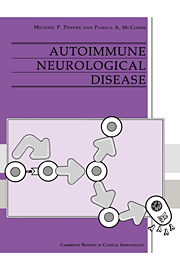Book contents
- Frontmatter
- Contents
- Preface
- 1 Antigen recognition and self–non-self discrimination
- 2 An introduction to neuroimmunology
- 3 Experimental autoimmune encephalomyelitis
- 4 Multiple sclerosis
- 5 Acute disseminated encephalomyelitis
- 6 The stiff-man syndrome
- 7 Experimental autoimmune neuritis
- 8 The Guillain–Barré syndrome and acute dysautonomia
- 9 Chronic immune-mediated neuropathies
- 10 Autoimmune diseases of the neuromuscular junction and other disorders of the motor unit
- 11 Inflammatory myopathies and experimental autoimmune myositis
- 12 Paraneoplastic neurological disorders
- 13 Neurological complications of connective tissue diseases and vasculitis
- Index
6 - The stiff-man syndrome
Published online by Cambridge University Press: 22 September 2009
- Frontmatter
- Contents
- Preface
- 1 Antigen recognition and self–non-self discrimination
- 2 An introduction to neuroimmunology
- 3 Experimental autoimmune encephalomyelitis
- 4 Multiple sclerosis
- 5 Acute disseminated encephalomyelitis
- 6 The stiff-man syndrome
- 7 Experimental autoimmune neuritis
- 8 The Guillain–Barré syndrome and acute dysautonomia
- 9 Chronic immune-mediated neuropathies
- 10 Autoimmune diseases of the neuromuscular junction and other disorders of the motor unit
- 11 Inflammatory myopathies and experimental autoimmune myositis
- 12 Paraneoplastic neurological disorders
- 13 Neurological complications of connective tissue diseases and vasculitis
- Index
Summary
Introduction
The stiff-man syndrome is a rare disorder of the central nervous system (CNS) characterized by progressive fluctuating rigidity and painful spasms of the body musculature. It was first described in 1956 by Moersch & Woltman, although they observed the first case of this condition much earlier, in 1924. Ironically, they nicknamed the disorder ‘stiff-man syndrome’ to ‘associate it with a memorable and descriptive term that could not be taken by anyone to be final’. Recently, evidence has accumulated that the stiff-man syndrome is an autoimmune disease directed against neurones secreting the inhibitory neurotransmitter, gamma-aminobutyric acid (GABA) (Solimena et al., 1990). The syndrome usually develops spontaneously and often occurs in association with other autoimmune diseases, particularly type I (insulin-dependent) diabetes mellitus. However, it may also occur as a paraneoplastic syndrome complicating remote malignancy.
Clinical features
General clinical features and diagnosis
The characteristic clinical picture is the insidious development of muscular tightness, stiffness and rigidity, initially involving the axial musculature (neck, paraspinal and abdominal muscles) and later spreading to affect proximal limb muscles (Moersch & Woltman, 1956; Gordon, Januszko & Kaufman, 1967; Lorish, Thorsteinsson & Howard, 1989). Mobility is restricted by the simultaneous contraction of agonist and antagonist muscles, so that the patient may be observed to walk or fall like ‘a wooden man’.
- Type
- Chapter
- Information
- Autoimmune Neurological Disease , pp. 166 - 176Publisher: Cambridge University PressPrint publication year: 1995
- 1
- Cited by

